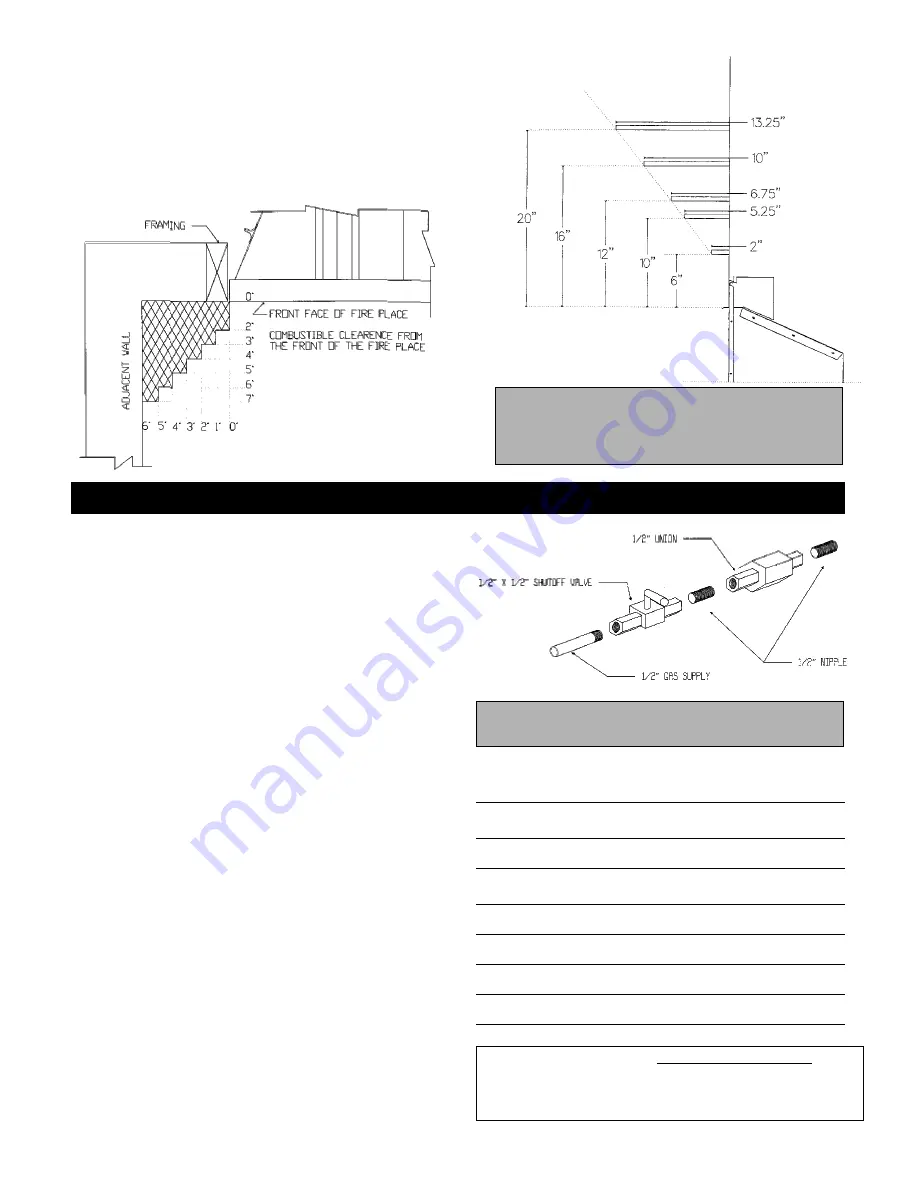
6
Gas Line Installation
This gas appliance should be installed by a qualified installer in accordance with
local building codes and with current CAN/CGA - B149.1 or .2 installation codes for
Gas Burning appliances and equipment in Canada and the National Fuel Gas Code
ANSI Z223.1 in the U.S.A.
1. The gas pipeline can be brought in through either the right or the left side of the
appliance. A knockout is provided at either location to allow for the gas pipe
installation and testing of any gas connection.
2. The gas control inlet is 1/2” NPT. Typical installation layout for rigid pipe is
shown at right.
3. When using
copper
or
flex connector
, use only approved fittings. Always
provide a union so that gas line can be easily disconnected for burner or fan
servicing. See gas specification for pressure details and ratings.
4. When a vertical section of gas pipe is required for the installation, a condensa-
tion trap is needed. See CAN/CGA-B149.1 or .2 for code details.
5. For natural gas, a minimum of 3/8” iron pipe with gas minimum pressure of 4.5
w.c. must be used for supply from the gas meter. Consult with the local gas
utility if any questions arise concerning pipe sizes.
6. 1/8” NPT plugged tappings are accessible for test gauge connection both on the
inlet and outlet of the gas valve.
7. Turn the gas supply ON and check for leaks. DO NOT USE OPEN FLAME
FOR THIS PURPOSE. Use an approved leak testing solution.
8. The appliance and its individual shutoff valve must be disconnected from the gas
supply piping system during any pressure testing of that system at test pressures
in excess of 1/2 PSIG (3.5 KPa).
9. The appliance must be isolated from the gas supply piping system by closing its
individual shutoff valve during any pressure testing of the gas supply piping
system at test pressures equal to or less than 1/2 PSIG (3.5 KPa).
Note: The gas line connection may be made of 1/2” rigid pipe, 1/2” copper pipe
or an approved flex connector. Since some municipalities have additional local
codes, it is always best to consult your local authorities and the current
CAN/CGA - B149.1 or .2 installation code in Canada or the National Fuel Gas
code ANSI Z223.1 in the U.S.A.
Gas Specifications
Model
Fuel
Gas Control
Maximum Input
ZV6500N Natural
Millivolt
20000 BTU
ZV6500LP Propane
Millivolt
20000 BTU
Gas Inlet
1/2” NPT
Gas Supply
Minimum
Normal
Maximum
Pressure
(inches water column)
Natural Gas
4.5
7.0
9.0
Propane Gas
10.8
11.0
12.0
Manifold
Natural Gas
3.5 inches water column
Pressure
Propane Gas
10.5 inches water column
Orifice Size
Natural Gas (0-4500 ft)
#46
Air shutter: closed
Propane Gas (0-4500 ft)
#54
Air shutter: 0.137”
Mantles
Depending on the width of the fireplace mantle, it may be installed
higher or lower from the top of the fireplace opening. See drawing and
chart below for proper installation height of your combustible mantel-
piece. Non-combustible mantles may be installed at any height above
the fireplace opening.
Note: When using paint or lacquer to finish the mantle, such paint
or lacquer must be heat resistant (250˚F) to prevent discoloration.
Warning:
Combustible objects must not be placed on
a non-combustible mantle unless the non-combustible
mantle meets the minimum height and width
requirements for a combustible mantle.
Important: Always check for gas leaks with a soap and water solution.
Do not use open flame for leak testing.
For the state of Massachusetts a
T-handle gas shut-off valve
must be
used on a gas appliance. This T-handle gas shut-off valve must be list-
ed and approved by the state of Massachusetts. This is in reference to
the state of Massachusetts state code CMR238.































